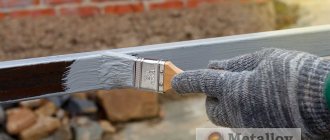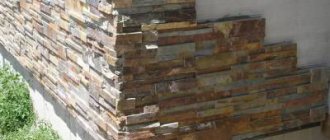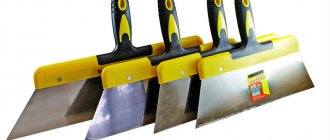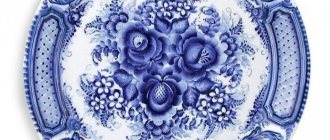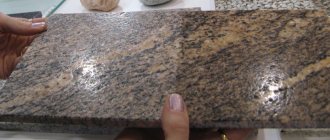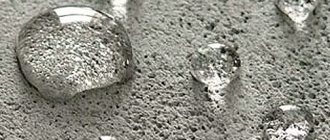«N
Natural interior design occupies a leading position among popular design styles for homes or commercial establishments from year to year. Among the mandatory finishing elements, wood, stone, and bamboo are relevant. They allow you to create an unusual atmosphere, filling the room with a certain lightness and peace. Being in such a room is not only pleasant, but also safe. Natural decorative elements emit positive energy that has a beneficial effect on the body.
However, among all the above materials, the most common is stone (artificial or natural). With its help you can decorate a fireplace, a closet, a room wall or even the external facade of a building. The variety of ideas allows designers to come up with new interesting solutions for the interior from year to year. In this case, the surface of the stone is coated with special substances to make it more attractive. One of the popular compositions is varnish. We will talk about its properties and application techniques in this article.
Varnished stone
Peculiarities
Each type of varnish for coating concrete has certain characteristics. They produce paints and varnishes that have increased wear resistance, resistance to high temperatures, and a high level of moisture resistance or fire resistance. But each varnish for concrete and stone has the following features and characteristics:
- very simple, easy and quick to apply. You can cover fairly large areas with varnish without spending a lot of time on this work;
- is universal. Each polymer varnish for concrete can be applied not only to a concrete base, but also to stone and brick;
- have a high wear resistance. Each type of varnish provides the treated surface with strength and resistance to mechanical stress and damage;
- attractive, decorative appearance. All protective varnishes look very beautiful on the surface.
Despite the fact that concrete and stone are strong materials, when exposed to conditions of increased mechanical stress or outdoors, under the influence of negative natural conditions, precipitation and temperature changes, the surfaces of these materials can begin to delaminate, crumble and turn into dust. Varnishes used for stone, concrete and brick can significantly strengthen the base. Protective varnishes are applied after the concrete has completely dried; the varnish composition strengthens the concrete surface, increases the technical characteristics and service life of this material.
Properties
In addition to protective characteristics, varnishes also have decorative properties. It depends on what substances are present in the composition. They are divided into two types:
- Glossy, semi-gloss effects, with the help of which the wet stone effect occurs.
- Matte and semi-matte effects that are suitable for high traffic floors.
Both the first and second types have almost the same properties. When working with a surface, for example, a fireplace or stove, it is necessary to take into account the temperature regime. You should also take into account when working on a surface that has high traffic.
- Maximum resistance to moisture and aggressive environments;
- Due to the fact that the substance penetrates into the material being processed, wear resistance increases;
- Resistance to external factors, high and low temperatures;
- Maximum surface strength;
- Minimal flammability;
- Long service life.
On video: impregnating properties of stone varnish.
Areas of application
Manufacturers produce concrete varnish for interior use and for application outdoors. Varnish solutions are usually used to coat the following objects:
- concrete floors, walls and ceilings;
- various fences and fences made of concrete;
- all kinds of concrete elements, street screeds, sidewalks, parking lots, industrial buildings;
- garden paths, blind areas made of concrete and stone, which are year-round under the negative influence of precipitation and temperature fluctuations.
Varnish is used on concrete to strengthen the material, make it resistant to abrasion, and also to make the stone more attractive.
Varieties
In stores you can buy various varnishes for concrete for exterior use and for interior decoration. For each type of varnish, a different base is used, depending on this, the compositions are:
- polyurethane. They have maximum moisture resistance, so they are mainly used in places where air humidity is constantly high. Often, polyurethane varnish for concrete is used for street work, where it is applied to sidewalks, paths, and also to protect swimming pools and saunas;
- polymer. This variety is one of the most popular and can be used for processing concrete, stone, during interior and exterior work. The surface becomes very durable and wear-resistant, this type of varnish is easy to apply and dries quickly enough;
- acrylic. Almost every acrylic varnish for concrete is expensive, so it is most often used for decorative work, when covering small products and surfaces. Acrylic compounds perfectly strengthen the base and increase the moisture resistance of the material;
- silicone. They are also quite expensive and are used mainly for interior work and for varnishing small items. Silicone solution combines excellent decorative properties and high moisture resistance;
- epoxy. These varnishes are used less frequently and contain special epoxy resins. Basically, these mixtures are two-component; before application, both components must be mixed together. Epoxy mortars can be applied to stone, plaster, mineral slabs and brick; they have a fairly high coefficient of chemical and mechanical resistance.
In addition to the fact that varnish solutions are divided by composition, varnishes can also be divided by type of gloss; there are the following varieties:
- glossy;
- matte;
- semi-gloss;
- semi-matte.
Gloss and semi-gloss are applied to create an attractive finish; they create the effect of wet stone. And matte and semi-matte solutions for concrete are used in those rooms where there is increased traffic, and the varnish layer experiences daily increased mechanical loads. This applies to industrial premises, public places such as train stations, airports, etc. On the matte surface, scratches and other defects are not very visible.
Properties
Stone varnishes with a wet stone effect have the following properties:
- Possibility of use for external and internal work.
- Strengthening the surface and structure of brick, tile, concrete, stone.
- Weather protection.
- Hydrophobization of the surface and protection against moisture.
- Decorative function: rich shade, shine.
- High level of adhesion.
- Insensitive to chemistry, UV, temperatures.
- Resistance to mechanical loads.
- Long service life.
Thanks to them, the decorative finishing of walls, floors or sidewalks lasts longer and looks more interesting.
Polyurethane varnish compositions
Despite the fairly high price, these materials are the most popular. They easily and quickly penetrate the base of concrete, strengthen the material, fill all cracks, which significantly increases the strength of the screed. You can use a polyurethane mixture together with an impregnation of the same composition, thanks to which the effectiveness of the layer will greatly increase. In addition, impregnation improves adhesion, as well as resistance to moisture and mechanical loads, which increases the service life of concrete.
One of the popular and high-quality compositions is Tistrom polyurethane varnish for concrete. A solution of this brand is most often used in garages, warehouses, workshops, and others. The main advantage of Tistrom varnish is its high resistance to the influence of chemical oils, petroleum products, and other technological solutions. This varnish mixture is easy to use; in addition to its excellent protective properties, it is visually attractive and decorative. Tistrom is not afraid of wet cleaning, which does not lose its technical characteristics. This mixture is also often used to strengthen concrete floors on farms, livestock farms, and industrial organizations.
How to apply protection
Protection is applied immediately after installation. First, the surface is cleaned and treated with special compounds with a gentle effect. They remove stains on the stone and remnants of building materials, but do not disturb its structure.
There are several types of cleaners:
- For acid-insensitive surfaces (non-polished granite).
- For surfaces sensitive to acid (marble).
None of them contain either acetone or solvent. Therefore, natural stone surfaces are cleaned carefully and their color is preserved. Afterwards, work is carried out to protect the material from moisture and staining. At the end, a finishing coating is applied in the form of varnish or impregnation.
Working with natural stone is a rather labor-intensive task, in which it is necessary to take into account all the manufacturer’s recommendations. Therefore, it is best to trust it to professionals.
Polymer varnish mixtures
They significantly enhance the quality of concrete; as a result, after using this varnish, the coating acquires very good performance properties. Polymer compounds repel moisture much better than polyurethane mixtures; they can effectively withstand aggressive environments and can be applied both indoors and outdoors. After the composition dries, the base becomes strong and durable; polymer solutions dry quickly enough, so they are often used to cover large areas.
The basis of these varnish mixtures is styrene, which makes the coating highly durable and resistant to various chemicals. One of the popular representatives of polymer solutions is Texol concrete varnish, which can be used as a decorative element when processing bricks, borders, paving stones, stone, and others. Texol is easy to apply, washes off very slowly after drying, and is highly resistant to the negative influence of the atmosphere.
Branded paints and varnishes with prompt delivery in Ukraine
You can buy branded varnish for stone without leaving your computer by placing an order online in the OXIDOM online store, which is the official dealer of paints and varnishes of famous brands in Ukraine.
In the illustrated catalog you will find a water-based stone varnish containing acrylic and silicone resins, as well as a range of other compositions for natural and artificial stone, brick, paving slabs, facades, borders and concrete. Finding the required composition greatly simplifies the availability of a detailed description of the characteristics of each product item. By the way, the whole of Ukraine can personally verify the excellent quality of the paints and varnishes we sell, because the order is delivered to any locality in the country.
Acrylic and silicone compounds
Although they are quite expensive, this is compensated by the small consumption of these mixtures when processing one square meter. Typically, silicone and acrylic based mixtures are matte. These solutions can be applied during ongoing production. The most rational use of these varnishes is to cover those areas that are subject to heavy loads and heavy wear.
A layer of this varnish applied to brick or stone will not turn yellow even after many years; the resulting film is highly protected from moisture. Silicone and acrylic mixtures usually have no odor and are safe for use indoors where people live. These varnish compositions can be applied to any building materials, including plaster and metal. By adding special pigments to them, you can give these solutions the necessary range and texture.
What varnishes are still used?
The advantage of the varnish is the ability to use it for interior and exterior decoration. It can be used in all climates as it is resistant to temperature and moisture. The following types of funds are used:
- Polymer. This mixture is waterproof. In addition, after treatment the surface dries quickly. This saves time when you need to cover a large area. It is used for external work to give the material decorative properties.
- Polyurethane. Used in construction, suitable for processing various surfaces. An organic solvent is mixed with polyurethane. When the product dries, a colorless film forms.
- Silicone and acrylic. Used for decorative purposes. Their main purpose is interior decoration. Is it possible to plaster over polystyrene foam with cement mortar? Moreover, the surface can be stone, brick, decorative. The film provides protection from moisture.
- Epoxy. Such varnishes are acceptable for processing wooden products. It is considered harmless, so it is used in furniture coating and interior decoration.
Rules and recommendations for application
It is worth remembering that any varnish for stone and concrete is a synthetic mixture, so protective equipment such as gloves, a respirator and goggles will not be superfluous. If the varnish composition is applied indoors, the room must be thoroughly ventilated.
Before applying varnish to the surface of concrete, brick or stone, these building materials must first be prepared. Preparation includes cleaning from dirt, dust, grease, drying, and, if necessary, priming. When applying varnish solutions, the air temperature should not exceed 35 degrees.
Almost all types of varnish mixtures can be applied using a roller, brush and pneumatic spray from a spray gun. If the substance is to be sprayed, it must first be diluted to the required viscosity. Varnishing must be done in at least two layers, and if the surface of concrete or other building material is very porous, then a minimum of three to four layers must be applied.
To ensure that the varnish solution does not unexpectedly run out during the application process, when purchasing it you need to correctly calculate the consumption per square meter and buy the required volume of the mixture. Experts recommend coating concrete bases with polyurethane products because they have the highest protection against moisture. And if you need to treat artificial stone or interior walls, then it is better to apply silicone or acrylic varnish products to them. But polymer ones are significantly cheaper and have a wide range of applications; they can be applied to both internal and external surfaces. Before you start using this or that product, be sure to carefully read the instructions.
Tips for cleaning natural stone
Despite its strength, stone is a very delicate material and requires care. This article provides recommendations for cleaning natural stone surfaces - how and what to wash it with. Even the types of stains are classified, because the choice of household chemicals depends on this.
General care
Place any glasses, especially those containing alcoholic beverages or citrus juice, on trays. Many drinks and foods contain acid that can corrode or discolor stone surfaces. Place hot dishes not on a stone surface, but on special mats. Place mats or napkins under porcelain, ceramic, or silver items that may scratch the surface.
Cleaning tips
FLOOR SURFACES Sweep floors with a dry, untreated mop or broom. Sand, dirt and abrasive particles cause the greatest damage to stone surfaces due to their abrasive ability. Rugs and mats on both sides of the main entrance will help minimize the entry of sand, dirt and abrasive particles onto the floor that can scratch the stone floor, as long as the bottom of the rug is non-slip. Usually eight steps is enough to remove all the sand or dirt from the sole of your shoes. Do not use used vacuum cleaners, as their plastic or metal wheels and attachments may also scratch the surface.
OTHER SURFACES Clean stone surfaces using a few drops of cleaner, stone soap (available at hardware stores or from a stone slab supplier) or mild liquid dish detergent and warm water. For best results, use a clean cloth mop to mop the floor and a soft cloth to mop other surfaces. Excessive detergent or soap may leave streaks. Do not use products containing citric, acetic or other acids on marble or limestone slabs. After cleaning, rinse the surface thoroughly with soapy water and dry with a soft cloth. Change the water frequently and do not use detergent powders or creams, as they contain abrasive substances that can scratch the surface.
BATHROOM AND OTHER WET SURFACES In the bathroom or other wet areas, soap scum can be minimized by scrubbing the surface with a rubber brush. To remove scum, use an acid-free scum remover or a water-based ammonia solution, although the stone surface may fade if ammonia is used too often.
WORK SURFACES Work surfaces may require a primer varnish. To prevent water marks from remaining, you need to treat the surface with non-yellowing wax in the form of a paste.
KITCHEN AREA Here you may need to use a sealant or primer that does not contain toxic components. Always consult the manufacturer.
COVERED Patio AND POOL AREA In the pool, patio or hot tub area, rinse the surface with clean water and use a mild bleach solution to remove algae or moss.
Properties of the stone
Natural stone comes in two types depending on its composition: siliceous or calcareous . Knowing the different properties of these stones is important when choosing cleaning products. Siliceous stone is mainly composed of silicon and quartz particles, is wear-resistant and can be easily cleaned with mild acidic cleaning solutions. Siliceous stones include granite, sandstone, quartzite, slate, ferruginous sandstone, and bluish sandstone (mica schist).
Limestone consists primarily of calcium carbonate. It cannot be washed with solutions containing acid, so it should be cleaned with products other than siliceous stone. Typical limestones are marble, travertine, limestone and onyx. A simple acid sensitivity test will help determine the type of stone. You will need 120 g of 10% hydrochloric acid solution or vinegar and a pipette. Since such an analysis can corrode the stone, perform this experiment on some remaining fragment. Apply a few drops of the acid solution to the surface of the stone. If the stone is calcareous, droplets of acid will begin to bubble or fizz. If no noticeable reaction occurs, then you are dealing with siliceous stone. Hydrochloric acid is a dangerous substance, so it is necessary to protect the surface of the skin from accidental contact.
Find out your stone
Granites and marbles are quarried in different parts of the world and come in different colors and mineral compositions. In most cases, marbles and granites can be identified by visible particles on the surface of the stone. Marble usually shows “veins,” or a high concentration of minerals. In granite, minerals are typically visible as small specks evenly distributed across the surface of the stone. Each stone has a unique color, texture and mottling.
Sandstones vary greatly in color due to the fact that the stone may contain various minerals and clays. Shades can vary from light gray to yellow or reddish. The dark red-brown sandstone is also called ferruginous sandstone. Bluish sandstone is a dense and hard stone with fine grains of greenish-gray or bluish-gray color.
Limestone is a widely used stone in construction with light gray, dark yellow or light brown shades. A characteristic feature of many limestones is the presence of fossil remains, often visible on the surface of the stone. Slate comes in dark green, black, grey, dark red or multi-colored. It is most commonly used to make floor slabs, roofing tiles and has a distinct lobular texture.
Stone finishing
Polishing allows you to achieve a shiny surface that reflects light and emphasizes the color and texture of the material. Similar finishes are used for walls, furniture and floor tiles.
Polished texture is a smooth, satin surface that reflects light relatively poorly. Overall, the honed finish is ideal for floors, stair treads, porch steps, and other high-traffic areas where the polish can quickly dull. Polished texture is also used in furniture and for finishing other surfaces. Fire finish is a rough textured surface often seen on granite floor slabs.
Stains
SPILLS AND STAINS Immediately blot up spills with a paper towel. Do not rub this area as this will only spread the spilled liquid. Wash the area several times with plain water and mild soap. Dry thoroughly with a soft cloth. Repeat the procedure if necessary. If the stain remains, refer to the stain removal section.
STAIN REMOVAL Identifying the type of stain on your stone surface is the key to removing it. If you don't understand what's causing the pollution, try playing detective. Where is the stain located: near a plant, a food preparation area, or a bedroom where cosmetics are used frequently? What color is the spot? What shape or pattern is it? What happens in the area around the spot? Surface stains are often easily removed with a cleaning product or household chemicals. Stains that are deeply embedded in the texture of the stone or cannot be cleaned with conventional cleaning products may require special sealants or professional intervention.
Types of stains and the first steps to remove them
OIL BASED (GREASE, TAR, BUTTER, MILK, COSMETICS) An oil stain causes the stone to darken and is usually dissolved by chemicals and then washed off. Gently wash the area with a mild, liquid cleaner containing bleach or household detergent, ammonia, lacquer thinner, or acetone.
